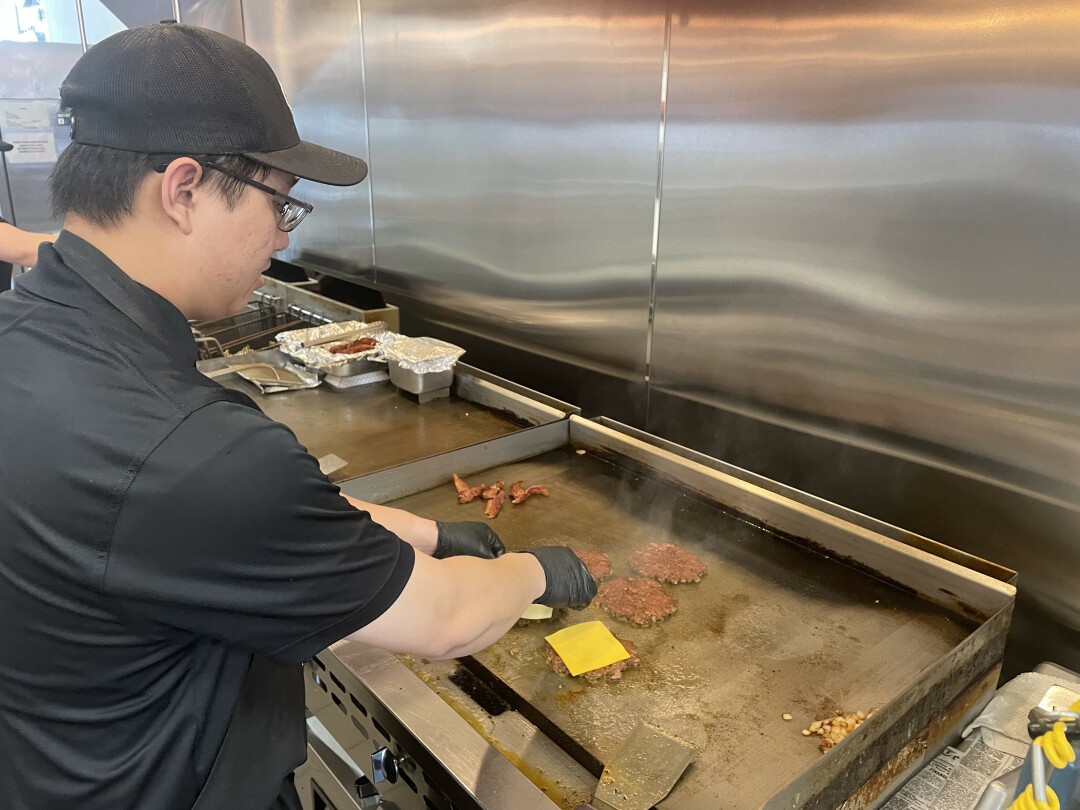News & Articles
Browse all content by date.

Joshua Trans at the King of Creams burger griddle. Photos by Ed Newman.
There are many reasons hamburgers are so popular. Let’s start with their versatility.
Hamburgers can be customized to suit individual preferences. From the type of meat to the choice of toppings, there are endless variations to suit different tastes and dietary restrictions.
Hamburgers are also convenient to eat on the go, making them a popular choice for busy individuals and families. They can be easily ordered at fast-food restaurants, food trucks, diners and even upscale eateries, providing a quick and satisfying meal option.
Burgers are famously associated with comfort food. They evoke feelings of nostalgia and familiarity. Many of us have fond memories of enjoying hamburgers at backyard barbecues or at family gatherings and social events.
The ability to customize hamburgers according to personal preferences appeals to a wide range of tastes and dietary restrictions. Whether someone prefers a classic cheeseburger or a gourmet creation with exotic toppings, hamburgers offer endless possibilities for expressive experimentation. And to a certain extent that is what this series of hamburger features is about, introducing you to new possibilities for your own culinary creativity.
This week we reached out to Courtland Powe, owner of The King of Creams, who started out with an ice cream food truck on the streets of Duluth. Today The King of Creams is a locally owned family business now housed in two locations, in the Central Hillside as well as Hermantown.
The Reader: What do you believe are the essential ingredients for a perfect hamburger patty?
Courtland Powe: Good cuts that have been ground to a fine texture with plenty of fat, a hot cooking surface and quality seasoning.
The Reader: Can you share any tips for selecting the best cuts of meat for hamburger patties?
CP: Look for cuts like chuck/brisket, chuck/brisket/short rib etc. For cost effectiveness as well as good flavor, we use a good quality chuck at a ratio of 80% muscle to 20% fat.
The Reader: What cooking techniques do you use to ensure juicy and flavorful hamburgers?
CP: Our cooking technique starts with a well-formed, tightly packed meat ball. Some people argue that you want your meat ball loosely packed. We disagree. Once that meatball is formed it gets smashed on a hot flat top griddle where a nice sear is made, allowing the juices from the meat to stay in the center where it belongs. We only season one side of the patty as well to give a nice balance of seasoning to meat.
The Reader: Do you have any special seasoning blends or marinades that you like to use for hamburgers?
CP: Yes. It’s proprietary but it consists of things like salt, onion powder, garlic powder etc. There is a special ingredient that a few people have been able to pick out since we’ve been in business but we neither confirm nor deny it when they do.
The Reader: How do you achieve the ideal balance of toppings and condiments to complement the burger patty?
CP: Everyone likes different things in terms of toppings, which is why we have chosen to offer a build your own model of burger. Personally, I prefer fried onions, sauteed mushrooms, fresh kosher dill pickles that must be refrigerated and a slice or two of tomato.
The Reader: Are there any unconventional ingredients or flavor combinations that you’ve experimented with in hamburger recipes?
CP: Years ago we had a food truck at the Blueberry Festival in Ely, Minn. In the spirit of the festival, we ground fresh wild blueberries into the meat and hand smashed the burgers on our flat top grill. It never really picked up for us there, but the blueberry flavor was very subtle and it added a lot of delicious moisture to the patty. I have contemplated adding that to the menu at our brick-and-mortar locations because it’s different, but who knows if people would respond.
The Reader: Can you share your preferred method for cooking hamburgers (grilling, pan-frying, broiling, etc.) and why you prefer it?
CP: Our preferred method of cooking burgers is a perfectly seared, hand smashed burger on a nice hot flat top griddle. The flavor is unadulterated by smoke and fumes and the true flavor of the meat is allowed to shine this way. The shape of the patty tends to be more consistent this way as well and doesn’t tend to shrink into a hockey puck, if you will.
The Reader: How do you ensure consistency in flavor and quality when cooking hamburgers in a restaurant setting?
CP: To ensure consistency, we weigh out every single patty and form them by hand into a meat ball. Of course this means we use high quality, fresh ground chuck. Once that meatball is formed and you place your order at the counter, we then place that perfectly formed ball on the flat top and smash it down to about 1/4” thick. Once it’s ready it gets seasoned and then scraped off the grill and flipped until the clear juices start to rise. We do this with every single burger we make and everyone is trained to do it the exact same way. Nothing sits in a warmer and it ensures a fresh high-quality product. It can get tricky to stay consistent when we are super busy, as space is limited but we do our best.
The Reader: Are there any additional tips or tricks you can share that you’ve learned through the years for making outstanding burgers?
CP: One tip I would say is make sure you choose your bun wisely. We sampled so many buns from so many places. We use a top-quality bakery fresh Egg Bun from Franklin Street Bakery in Northeast Minneapolis. It’s got a subtly sweet flavor that pairs well with our seasoned patty.
The Reader: What are your recommendations for achieving the perfect texture and doneness in hamburger patties?
CP: Don’t overcook the burger. Get that sear and cook it only till it’s done, which is around 155-160 degrees. If you remove the patty from the heat when it’s around 150 degrees it will keep cooking and ensures you don’t overcook.
| Tweet |


